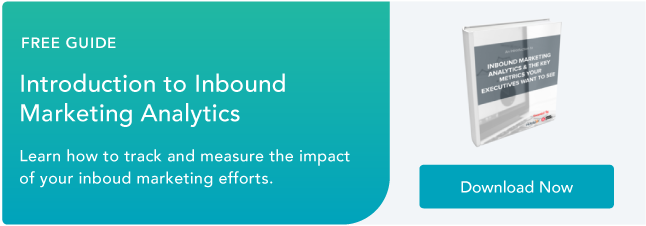

When many people start diving into their marketing analytics, they're nervous. Maybe they're new to the technology, so they're worried about it being too complex and confusing to use. Maybe they haven't analyzed their marketing before. Maybe math was never their strong suit. Or maybe they're just worried about messing something up.
It doesn't have to be this way. If you have the data that needs to be analyzed, some helpful analytics resources, and a little confidence in yourself, you can report on your analytics.
This post should help you with the latter two. We'll dive into some of the common misconceptions about analytics and give you some resources to reference so you can get past that nervous phase and on to the good stuff: actually measuring your marketing. Let's get to it!
Myth #1: You must have a mathematical background to do analytics.
This may have been true at one point, but now there are more opportunities than ever for people who don't have a math background to learn about analytics.
First, there are now more tools that ever that make it easy to find your data -- it's just your job to do the analysis. (Many platforms, like HubSpot, can even help you with that.)
Second, there are also a ton of resources out there to teach yourself analytics. You can subscribe to blogs or even take free online classes that will teach you about the important trends to look for in your data and how to improve your metrics. None of these require understanding calculus or having the ability to code.
Myth #2: Analytics always take a lot of time to measure.
Many marketers worry that analytics will take up too much time -- they won't have any left to do actual work!
But that's not always the case. Once you figure out which metrics you should be routinely measuring and how to track them in your software, it's usually pretty quick to measure. You will know exactly where to pull them and how to make changes in your marketing based off of them. These analytics won't necessarily take that long to work with.
Sure, when you're trying to answer a new question or solve a different problem, you will find that analyzing your data can take longer. However, you may be surprised that it doesn't take as long as you thought it would.
If you want some help with measuring your analytics more efficiently, here are some blog posts you should check out:
- How to Use Excel: 14 Simple Excel Shortcuts, Tips & Tricks
- How to Analyze Your Blog Posts: A Beginner's Guide
- When to Check on Your Marketing Metrics: A Simple Guide
Myth #3: Analytics won't tell you anything you don't already know.
Just because you think you know how a campaign is going to turn out doesn't mean it's actually going to turn out that way. Every time you run a campaign, you should analyze the type of content and channels that are performing well. The results you get may never be the same. Your conversion rates on email marketing will be different than social media which will be different than organic search. And these metrics may vary from campaign to campaign. The only way for you to be certain about your campaign's results is to actually sit down and measure them.
Myth #4: Your company isn't big enough to need any analyses.
From the time your first piece of content is written, you should be thinking about how you're going to analyze it. Why? If you don't think about analysis from the start, you may miss opportunities to add tracking in your content.
For example, if you want to track the number of times someone clicks on a text link in your blog post, you need to think about adding tracking in there from the beginning. Or if you want to track what channel attracts the most traffic to your blog post, you need to add tracking information into the link that you share on different networks (Note for HubSpot customers: HubSpot will automatically track all links that you post through Social Inbox or the Email App.)
Also, if you are part of a company just starting out, you will need to rely on metrics to understand how to grow -- and find out if you are actually growing. Make sure your company is tracking visitor-to-lead conversion rates, and lead-to-customer conversion rates. This will help your understand if there's an area of the funnel that is not working and help you decide what to focus on. Also track these metrics based on channel (social media, email, organic, etc.). This will help you figure out what promotional channels are really working for you.
If you are not using a marketing platform to keep track of how your metrics increase or decrease over time, use a Google Spreadsheet or Excel to keep track of your progress. Here is a template that can help you get started.
Myth #5: You must report on every single metric.
If you wanted to, you could spend 100% of your time reporting on every single metric available. There is an endless amount of data that you can pull and analyses you can conduct. However, not all of it is important to your company.
So before you run a data analysis, set goals and write down the questions that you want answered by your analysis. Don't get carried about by reporting on everything; try to stay focused. This blog post can help you figure out when to track certain metrics.
Myth #6: You only need to report on visits and leads.
To better understand how many visits and leads you are getting on your website, there are other metrics that are necessary to track using a tool like the HubSpot Sources App or Google Analytics.
First, you need to report on the traffic and leads that you're getting from different marketing channels. That means understanding how many visits and leads you have on your site as a result of organic search, social media, email marketing, paid, and more. This will help you figure out where to spend your time promoting your content.
You also need to understand the conversion rates of these different channels. For example, if you just look at your website's overall traffic and leads, you may miss an opportunity to see that your visitor-to-lead conversion rate for email marketing is actually much higher than social media. This will be a good indication that you should promote your content through email marketing more than social media.
Also, don't forget about the middle and the bottom of the funnel. When you report on visits and leads, you are doing a great job of reporting on how your marketing is performing at the top of the funnel -- but to truly prove out your marketing is working, you should investigate the whole funnel. For example, one channel or piece of content may be great at converting leads but terrible at converting those leads into customers, so you might not want to dump more resources into it. By analyzing the full funnel, you'll be able to make smarter decision.
These are just examples of some of the important metrics you should report on. Depending on your company goals, there may be other metrics that you need to prioritize.
Myth #7: Data from different software platforms should always look the same.
Different software platforms have different definitions for their metrics. A great example of this is Google Analytics and HubSpot. In Google Analytics, a visit is anytime someone comes to your site from a referring source. All interactions on your website are counted as the same visit for the next 30 minutes. In HubSpot, a visit is anytime someone comes to your site from a referring source regardless of the time frame. As a result, the number of visits in Google Analytics and the number of visits in HubSpot will be slightly different.
So don't try to compare the data from different software platforms -- instead, compare trends. You should see the same general increases and decreases in your data pulled from different platforms. Don't worry about the fact that one piece of software says you have 50 more visits than the other.
If for some reason the trends in your data is not matching up, double check that your tracking is set up correctly. For example, if your tracking code for each platform is not on all of your pages, you may see some bigger differences. Check with your software provider to make sure you are set up correctly.
Myth #8: Having data matters more than taking action from your data.
Pulling data for the sake of having data is pointless. It takes time out of your schedule that could be used to create content, run campaigns, or develop a strategy for your next project.
So don't let your data go to waste. When you conduct a data analysis, plan on taking action based on what the data says. If you run an analysis on a campaign you are running, and the analysis shows that your approach is not working, don't be afraid to make changes halfway through your campaign.
The most important part of any data analysis is the ability to pull out insightful information and take action based on your findings. As you analyze your data, think about how you can incorporate your findings into your current or future campaigns.
What other myths have you heard about data and analytics? Let us know in the comments.



![A Simple Guide to Marketing ROI [Formula & Examples]](https://blog.hubspot.com/hubfs/a-simple-guide-to-marketing-ROI.webp)






